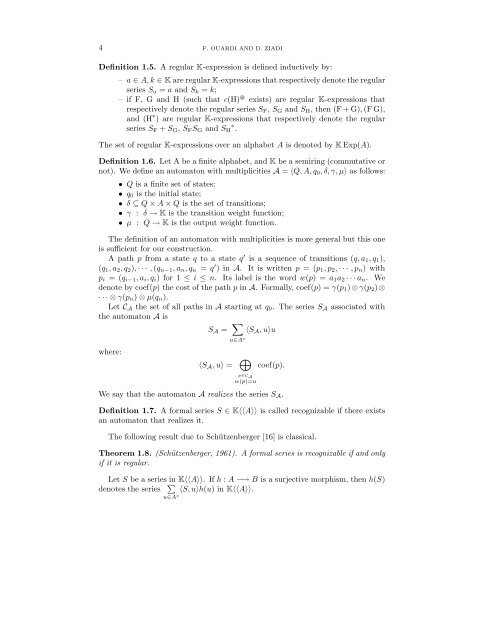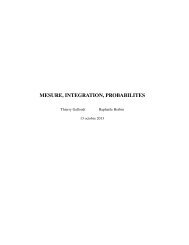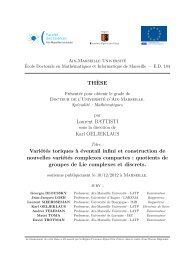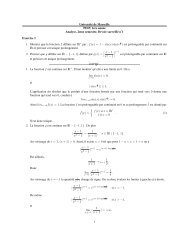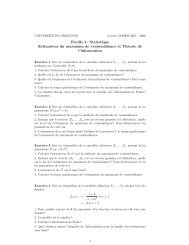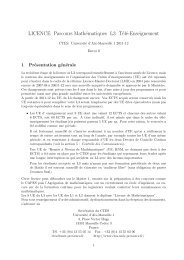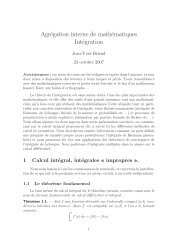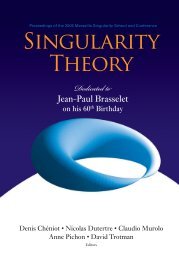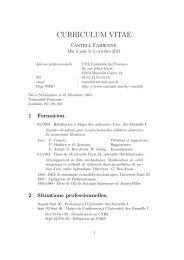Faissal Ouardi and Djelloul Ziadi Introduction - CMI
Faissal Ouardi and Djelloul Ziadi Introduction - CMI
Faissal Ouardi and Djelloul Ziadi Introduction - CMI
Create successful ePaper yourself
Turn your PDF publications into a flip-book with our unique Google optimized e-Paper software.
4 F. OUARDI AND D. ZIADI<br />
Definition 1.5. AregularK-expression is defined inductively by:<br />
– a ∈ A, k ∈ K are regular K-expressions that respectively denote the regular<br />
series Sa = a <strong>and</strong> Sk = k;<br />
– if F, G <strong>and</strong> H (such that c(H) � exists) are regular K-expressions that<br />
respectively denote the regular series SF, SG <strong>and</strong> SH, then(F+G), (F G),<br />
<strong>and</strong> (H ∗ ) are regular K-expressions that respectively denote the regular<br />
series SF + SG, SFSG <strong>and</strong> SH ∗ .<br />
The set of regular K-expressions over an alphabet A is denoted by K Exp(A).<br />
Definition 1.6. Let A be a finite alphabet, <strong>and</strong> K be a semiring (commutative or<br />
not). We define an automaton with multiplicities A = 〈Q, A, q0,δ,γ,μ〉 as follows:<br />
• Q is a finite set of states;<br />
• q0 is the initial state;<br />
• δ ⊆ Q × A × Q is the set of transitions;<br />
• γ : δ → K is the transition weight function;<br />
• μ : Q → K is the output weight function.<br />
The definition of an automaton with multiplicities is more general but this one<br />
is sufficient for our construction.<br />
Apathp from a state q to a state q ′ is a sequence of transitions (q, a1,q1),<br />
(q1,a2,q2), ··· , (qn−1,an,qn = q ′ )inA. It is written p =(p1,p2, ··· ,pn) with<br />
pi =(qi−1,ai,qi) for1≤ i ≤ n. Its label is the word w(p) =a1a2 ···an. We<br />
denote by coef(p) the cost of the path p in A. Formally, coef(p) =γ(p1) ⊗ γ(p2) ⊗<br />
···⊗γ(pn) ⊗ μ(qn).<br />
Let CA the set of all paths in A starting at q0. The series SA associated with<br />
the automaton A is<br />
where:<br />
SA = �<br />
〈SA,u〉u<br />
u∈A ∗<br />
〈SA,u〉 = �<br />
p∈C A<br />
w(p)=u<br />
coef(p).<br />
We say that the automaton A realizes the series SA.<br />
Definition 1.7. AformalseriesS ∈ K〈〈A〉〉 is called recognizable if there exists<br />
an automaton that realizes it.<br />
The following result due to Schützenberger [16] is classical.<br />
Theorem 1.8. (Schützenberger, 1961). A formal series is recognizable if <strong>and</strong> only<br />
if it is regular.<br />
Let S be a series in K〈〈A〉〉. Ifh : A −→ B is a surjective morphism, then h(S)<br />
denotes the series �<br />
〈S, u〉h(u) inK〈〈A〉〉.<br />
u∈A ∗


